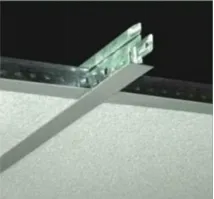- Afrikaans
- Albanian
- Amharic
- Arabic
- Armenian
- Azerbaijani
- Basque
- Belarusian
- Bengali
- Bosnian
- Bulgarian
- Catalan
- Cebuano
- Corsican
- Croatian
- Czech
- Danish
- Dutch
- English
- Esperanto
- Estonian
- French
- German
- Greek
- Hindi
- Indonesian
- irish
- Italian
- Japanese
- Korean
- Lao
- Malay
- Myanmar
- Norwegian
- Norwegian
- Polish
- Portuguese
- Romanian
- Russian
- Serbian
- Spanish
- Swedish
- Thai
- Turkish
- Ukrainian
- Uzbek
- Vietnamese
nov. . 06, 2024 19:43 Back to list
Elevating Your Space with Innovative Drywall Ceiling Grid Solutions
Understanding Drywall Ceiling Grid Systems
In modern construction and interior design, the ceiling plays a pivotal role in both aesthetics and functionality. Among the various ceiling types available, the drywall ceiling grid system stands out due to its versatility and structural advantages. This article aims to explore the components, installation process, and benefits of a drywall ceiling grid, providing readers with a comprehensive understanding of this essential element in contemporary spaces.
Components of a Drywall Ceiling Grid
A drywall ceiling grid system is composed of several key components that work together to create a sturdy framework for ceiling panels. The primary elements include
1. Grid Framework The framework is typically made of metal or PVC and consists of main beams and cross tees that create a grid pattern. The grid serves as the backbone for the drywall panels, providing support and ensuring they remain level and secure.
2. Drywall Panels Standard drywall sheets, often 5/8-inch thick, are used to cover the grid framework. These panels can be finished in a variety of textures and colors, allowing for customization to fit the desired aesthetic of the space.
3. Hangers and Clips To secure the grid framework to the ceiling, hangers (often wire or straps) and clips are employed. These components are crucial for ensuring stability and preventing the grid from sagging over time.
4. Finishing Materials Once the drywall is installed, finishing materials such as joint compound, tape, and primers are applied to create a smooth, seamless appearance. This step is vital for achieving a polished look and enhancing durability.
Installation Process
Installing a drywall ceiling grid involves several steps
. Here’s a brief overview of the process1. Planning and Measurement Before installation, accurate measurements of the room are essential. The ceiling height, the desired drop, and the layout of fixtures such as lights or fans should be documented.
2. Marking Levels The installation begins by marking a level line around the perimeter of the room at the desired height of the new ceiling. This line will guide the placement of the grid framework.
3. Installing Hangers Hangers are then installed on the ceiling joists or structural supports at regular intervals to provide necessary support for the grid.
drywall ceiling grid

4. Assembling the Grid Following the installation of hangers, the main beams and cross tees are assembled and secured into place, forming the grid structure.
5. Installing Drywall Panels Once the grid is established, drywall panels can be cut to fit and attached to the grid using screws. Care should be taken to avoid gaps between panels for a seamless appearance.
6. Finishing Touches The final steps involve taping, mudding, and sanding the joints before applying a primer and paint. This process not only enhances the visual appeal of the ceiling but also helps in soundproofing and insulation.
Benefits of Drywall Ceiling Grid Systems
There are several advantages to using a drywall ceiling grid system in a variety of settings, including residential, commercial, and industrial spaces
1. Aesthetic Flexibility Drywall ceilings can be customized with different textures, colors, and finishes, allowing designers to create unique environments. This flexibility helps in achieving the desired ambiance in any space.
2. Easy Access to Infrastructure One of the significant benefits of a grid system is the ease of access it provides to plumbing, electrical, and HVAC systems installed above the ceiling. If maintenance or repairs are required, panels can be easily removed and replaced without disrupting the entire ceiling.
3. Sound Dampening Drywall has excellent sound absorption properties. When combined with a grid system, it can effectively reduce noise transmission between rooms, making it a preferred choice for offices and residential areas alike.
4. Fire Resistance Many drywall products are designed to be fire-resistant, contributing to overall safety in buildings. This characteristic is particularly critical in commercial and industrial settings where fire safety regulations are stringent.
5. Cost-Effectiveness Compared to other ceiling systems, drywall ceilings can be more economical in both materials and labor, making them a popular choice for budget-conscious projects.
Conclusion
Drywall ceiling grid systems are a practical and aesthetically pleasing option for enhancing the functionality and appearance of interiors. Their ease of installation, accessibility to essential infrastructure, and versatility make them a favored choice across various industries. Whether you are renovating a home or designing a commercial space, understanding the principles of drywall ceiling grids can help you make informed decisions that contribute to the success of your project.
-
Transform Interiors with PVC Gypsum Ceiling: A Stylish, Durable, and Moisture-Resistant SolutionNewsMay.19,2025
-
The Smart Interior Upgrade: Discover the Durability and Versatility of Gypsum Ceiling Access Panel SolutionsNewsMay.19,2025
-
The Smart Choice for Interior Design: Discover the Value of PVC Gypsum Ceiling SolutionsNewsMay.19,2025
-
Mineral Fiber Ceiling Tiles: The Smart Blend of Performance and AestheticsNewsMay.19,2025
-
Mineral Fiber Ceiling Tiles: The Superior Choice Over Gypsum for Sound and Fire SafetyNewsMay.19,2025
-
Mineral Fiber Ceiling Tiles: Eco-Friendly Strength and Style for Every CeilingNewsMay.19,2025







